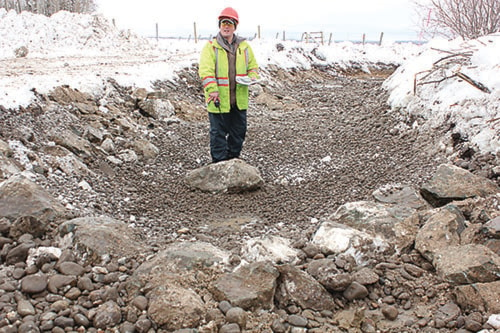The diversion of Murray Creek means soon the stream will harbour a more fruitful riparian habitat.
The Nechako Environmental Water Stewardship Society (NEWSS) started physical work of the Murray Creek Restoration Project (MCRP) last month with help from Avison Management Services, a Vanderhoof based consulting company.
Soon Murray Creek will no longer start at the culvert on Larson road and flow north west into the Nechako River, but will revert back to it’s historical channel heading south and south west, Olin Albertson said, biologist with Avison.
“And to accommodate for extra flow [because of the mountain pine beetle] we’re going to overbuild it a little,” Albertson said.
NEWSS started seven years ago with the idea of promoting water stewardship values in the Nechako Valley.
The MCRP was created to restore the stream back to a level where it would again support a vibrant fish population by reducing the erosion of farm land into the Nechako River.
NEWSS initially had a modest budget of $30,000 with more than $17,000 coming from within the BC Cattleman’s Associations Farmland - Riparian Interface Stewardship Program (FRISP).
“The success to date on this stream has now grown to over 15 projects having been completed to date with an expenditure this year alone on Murray Creek forecasted to be around $400,000,” Wayne Salewski chair of NEWSS, said in an email interview.
The MCRP is managed by NEWSS which has grown to cover more than 32 streams within the Nechako Valley with active projects on Stoney Creek, the Chilako (Mud River) and Knight Creek. A further partnership with the Nechako Watershed Alliance comprises of over 25 regional stakeholders including local governments, UNBC, the Ministry of Forest Lands Natural Resources and Saik’uz First Nations to name a few.
“[NEWSS] is working towards a watershed governance model that will be brought forward in the next year,” Salewski said. “The Regional Cattleman’s Association has a director on NEWSS and is an active participant in bringing forth changes within the region on how farms and ranches operate within the Nechako Valley. NEWSS expects to announce both a major funding partner with the next month that will see a commitment for a million dollars over the next five years from the Nechako Environmental Enhancement Fund (NEEF) along with our first MOU with a Vanderhoof based forest company that confirm a working relationship with them and our many restoration projects.”
In the past, farmers cleared their land or had livestock graze right up to the edge of the stream. For over twenty years this section of Murray Creek has been diverted allowing sediments to fill spawning areas and be flushed into the Nechako River as one of many sources of sediment.
“Sediments (fine particles) are detrimental to fish particularly for spawning because sturgeon rely on interstitial spaces in between the gravel. They need good size gravel free of sendiment so eggs can attach in spaces. If sendiments come they could cover them and potentially kill them,” Mr. Albertson said.
Tree roots also play an integral role for water flow, seeping it up for slow release. With all the logging of dead trees due to the pine beetle, water flushes through stream systems much faster, Albertson said.
Along with the stream’s full reconstruction, Avison will plant various coniferous, cotton wood and willow. Additional features such as numerous deep pools will also provide rearing and over-winter habitats with large woody debris incorporated for stream stabilization and providing cover for fish.
“Riparian habitat acts as a natural filter providing shade, insects on trees which fall and feed fish, a buffer of vegetation, root structure and stability. Without it the bank can erode and even move substantial distances over time,” Mr. Albertson said.
Up-stream rock and wood weirs (walls) will also help with water flow. Having a place where the water will be held back a bit but can still run through the rock will form a plunge pool of oxygenated water. Small spawning gravel mixed with oxygenated water will be great for spawning habitat, Mr. Albertson said.
“In a fast system the fish don’t have to work as hard because these things will help slow the water down,” Mr. Albertson said.
Part 2 of the project will be replacing the three undersized culverts on Larson Road with one large one. Having three small long ones makes water flow through much quicker and may prevent fish from swimming up or down stream. By replacing them with one big culvert, the water will be able to flow through at a slower pace and fish will be able to swim freely.
“We don’t have Chinook salmon spawning in Murray Creek but once they emerge from gravels they will actually come into smaller systems to rear for a year or two. They are anadromous (live part in fresh water, part in ocean) and once they spend their first years in fresh water rearing they head back down the Fraser River and into the Ocean. This creek will provide essential habitat for Chinook Salmon along with many other resident spieces such as rainbow trout, dace, suckers and minnows,” Mr. Albertson said.
The entire project is about 630 meters and NEWSS is hoping to divert the water sometime before spring.
“NEWSS is very pleased with our growth over the past years and is looking forward to announcing further partnerships in the months ahead as we work towards making the Nechako Valley, a showcase for cooperation between industry, First Nations and ourselves, as we bring water stewardship values forward for the betterment of the Nechako River,” Salewski said.
